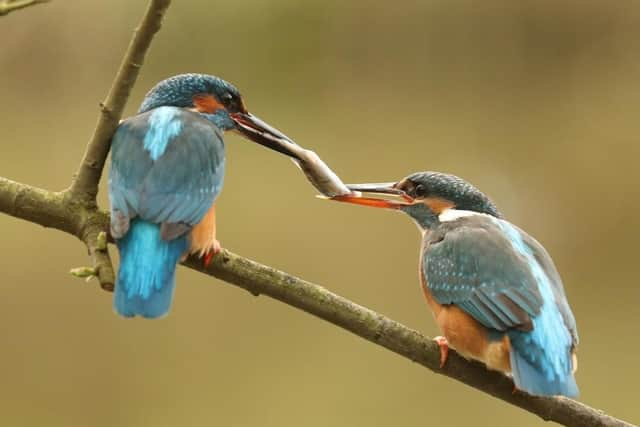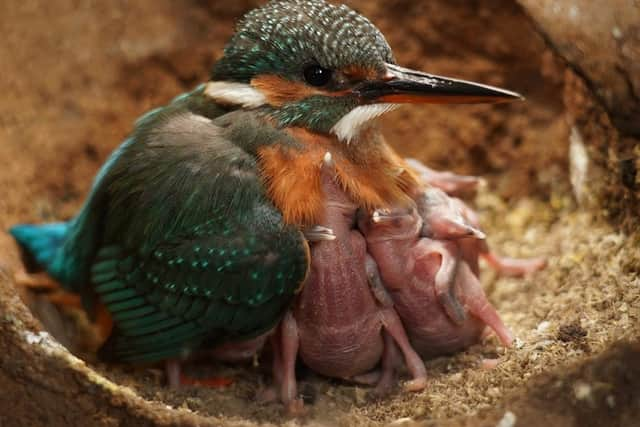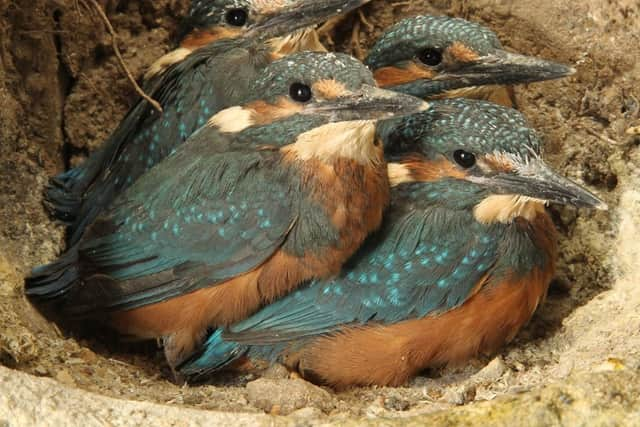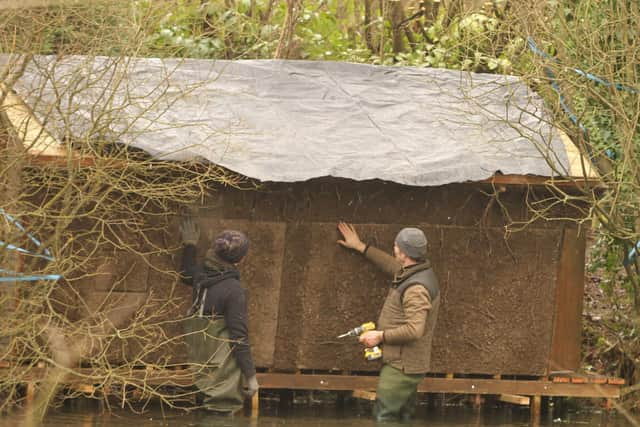Wildlife artist Robert Fuller creates a hide and films the fascinating secret life of kingfishers and their young
But I’ve always longed to discover what happens when these bright birds disappear underground to bring up their young in the dark.
And so one cold January, as I splashed thigh-high through a stream, minnows darting before each footstep, I heard a high-pitched peeping and slowed my pace just in time to spot a flash of orange and cobalt blue whizz by.
Advertisement
Hide AdAdvertisement
Hide AdI followed the sound looking for a steep bank where this kingfisher might be nesting. But finding nowhere suitable I headed instead to some nearby flooded gravel pits owned by a friend.


Here she complained that the bank where kingfishers regularly nest had collapsed – a lack of nesting sites is a major problem.
I offered to restore the bank in exchange for setting up a hide. I replaced the missing bank with a bespoke shed coated in earth and tree roots so that it fitted naturally into its new waterside location.
Inside the shed I placed an artificial nesting chamber and a CCTV camera system. With the help of two friends, we placed it in situ over four freezing cold February days.
Advertisement
Hide AdAdvertisement
Hide AdI returned a few weeks later to discover the tunnel to the nesting chamber worn smooth and splattered with white droppings. Inside was a cream pellet the size of a peanut. I crumbled it between my fingertips to reveal fine fish bones and tiny translucent scales, evidence kingfishers were using the nest. Silently, joyfully, I punched the air!


To avoid disturbance I set my CCTV cameras rolling and left the site for several more weeks; only visiting after dark to scan furtively through the footage. Mostly I saw the female coughing up, then carefully shredding pellets over the nest floor.
There was no footage of the pair together, but this didn’t surprise me. Kingfishers are solitary birds and have to overcome a natural aversion to one another in order to breed.
From my hide, I observed an awkward undertone to their courtship. Once the male put on a spectacular aerial display for the female, but then turned and plummeted down at her, whizzing so close her feathers flattened in the slipstream.
Advertisement
Hide AdAdvertisement
Hide AdBut when they called to each other, pinging whistling ‘peeps’ back and forth, it was sweetly hypnotic.


Then the male dove for a fish and the female fluffed up her feathers, flirting and begging ‘chi-chi-chi’ until he offered her his catch. She accepted with quivering wings but as she gulped it down he stood bolt upright, his tail fanned and sharp beak pointing skywards in a posture similar to his aggressive stance.
Known as the ‘fish pass,’ this marked a monumental stage in their relationship. Nevertheless it was several days and several more fish passes before he eventually hovered over her to mate.
A few days later, I switched on the monitor linked to cameras inside the nest to find one beautiful, shiny white egg.
Advertisement
Hide AdAdvertisement
Hide AdKingfishers lay every 24 hours and so the next day I settled into my hide well before dawn. There was a rustle as she waddled up the tunnel, feeling her way through the darkness with her beak, and located her egg with a gentle tap. I held my breath: if I had timed this correctly, she was about to lay her second egg.


She laboured for an hour, her tail pumping up and down, then stood and scuffled out of the nest, croaking. There were now two eggs. It is hard to describe my feelings at having been just one metre away from a laying kingfisher. She went on to lay seven pristine eggs, each as precious as pearls and I was alongside her for six.
The pair switched brooding duties like clockwork. The male would arrive at the entrance and peep, as if ringing the doorbell, and as she waddled out he scuttled in.
But as hatching day approached, she refused to fly out when he checked in. Confused, he entered the tunnel and she rushed at him. Their beaks locked and twisted and turned, like duelling swords. The eggs scattered. The female chased him back down the tunnel, slashing at him with her beak. Inside my hide I gasped at the brutality.
Advertisement
Hide AdAdvertisement
Hide AdNot long after, the male entered the chamber with a tiny fish clasped in his beak. He rasped loudly and the female rocked briefly to one side to reveal six eggs and one pink, featherless chick.
The male rasped again, encouraging this wobbly chick to feed and it swayed fitfully towards the fish. By some magic it aligned gaping mouth with minnow and swallowed it down whole.
All seven eggs hatched successfully. Then tragedy struck and a cold front lasting three long days swept in. Adverse weather is one of several reasons for the kingfisher’s decline. Torrential rain and freezing temperatures meant three chicks perished.
When the weather improved, I noticed the female courting again. This is quite normal kingfisher behaviour and second broods will frequently overlap with the first. Soon, I spotted grains of soil on their beaks; evidence that a new nest was being built elsewhere.
Advertisement
Hide AdAdvertisement
Hide AdThe female was now largely absent, no doubt tending to a new clutch of eggs, and her mate was left in sole charge.
Kingfisher chicks fledge at around 27 days old and so on the last day I arrived early only to discover one chick had already flown the nest. Interestingly, the female, who had been absent for nearly ten days, was also there, calling encouragingly to the chicks inside.
At the sound, one chick headed down the tunnel and launched out of the bank. Minutes later a second fledged and then the final chick, realising it was home alone, panicked and rushed about and crashlanded into the stream, rebounding off the surface before settling on to a thin reed.
It was a proud moment. Here were the chicks I had watched from tiny hatchlings mastering the skills they would need when the parent’s leave them to fend for themselves.
Robert’s gallery in Thixendale is now open for private viewings of a maximum of six. Visit robertefuller.com to book a timed appointment.
Comment Guidelines
National World encourages reader discussion on our stories. User feedback, insights and back-and-forth exchanges add a rich layer of context to reporting. Please review our Community Guidelines before commenting.